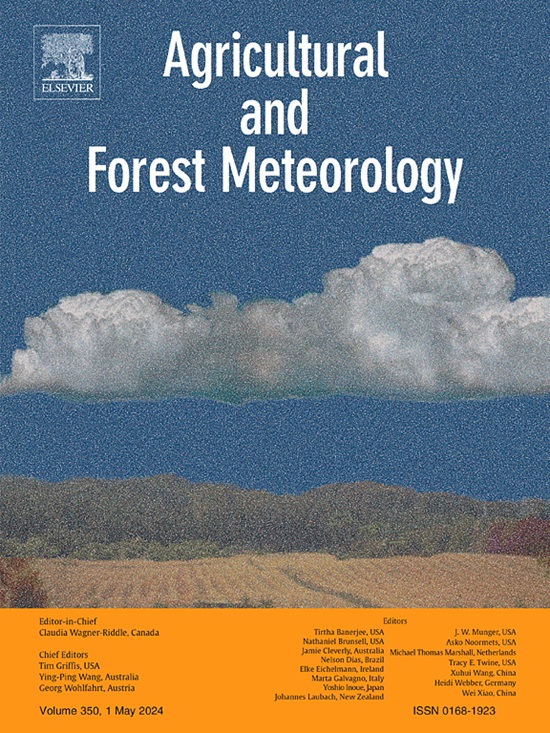LiDAR insights on stand structure and topography in mountain forest wind extreme events: The Vaia case study
IF 5.6
1区 农林科学
Q1 AGRONOMY
引用次数: 0
Abstract
With climate change intensifying, forests globally are becoming more susceptible to extreme weather events, such as windstorms, which account for a significant share of Europe’s economic losses. The Vaia windstorm of late autumn 2018, striking Italy’s North-East alpine ecosystem, highlighted this vulnerability, toppling over 8.5 million cubic meters of timber and sparking debates on forest management’s role in mitigating such disasters. This study aims to evaluate the impact of structural and topographical characteristics on the damage caused by Vaia, using Airborne Light Detection And Ranging (LiDAR) data collected before the storm, in four heavily affected forest areas in the Italian Alps (Carezza in the Province of Bolzano-Bozen, Predazzo, Manghen, and Primiero in the Province of Trento). We analyzed structural metrics like forest height heterogeneity (HH), forest mean height, and density, alongside topographical features such as aspect, slope, and altitude, to discern their influence on the storm’s severity. Our results revealed that the most significant difference between affected and unaffected areas is forest mean height that was found higher in areas hit by the storm. Forest density played a lesser but important role, with denser areas experiencing more severe damage, though this was only significant in certain areas. Contrary to common assumptions, our analysis revealed that forest height heterogeneity (HH) did not have a significant effect on damage levels. The findings, consistent with previous research, revealed a significant association between specific aspects, particularly the South-East orientation, which aligned with the predominant wind direction during the Vaia storm, and an increased likelihood of damage. Both structural and topographical factors interact in complex ways to influence the outcome of such extreme events. The study emphasizes the dominant impact of the Vaia windstorm, noting that while managing forest height and density may help, the diverse topography complicates these efforts. Our study explicitly tested the effectiveness of using Airborne LiDAR data to explore forest structural and topographical factors that influenced Vaia storm damage. The achieved results demonstrate that LiDAR serves as a useful tool to field data, offering valuable insights for broader applications in this domain.
激光雷达对山林风极端事件中林分结构和地形的洞察:维亚案例研究
随着气候变化的加剧,全球森林越来越容易受到风灾等极端天气事件的影响,而风灾占欧洲经济损失的很大一部分。2018 年深秋袭击意大利东北部高山生态系统的维亚风灾凸显了这种脆弱性,超过 850 万立方米的木材被吹倒,引发了关于森林管理在减轻此类灾害中的作用的讨论。本研究旨在利用暴风雨前收集的机载光探测和测距(LiDAR)数据,评估结构和地形特征对 "维亚 "所造成破坏的影响,研究对象是意大利阿尔卑斯山的四个重灾林区(博尔扎诺-博岑省的 Carezza、特伦托省的 Predazzo、Manghen 和 Primiero)。我们分析了森林高度异质性(HH)、森林平均高度和密度等结构指标,以及地形特征(如地势、坡度和海拔),以确定它们对风暴严重程度的影响。我们的研究结果表明,受影响地区与未受影响地区之间最显著的差异是森林平均高度,受风暴袭击地区的森林平均高度更高。森林密度的作用较小,但也很重要,密度较高的地区遭受的破坏更严重,但这只在某些地区显著。与通常的假设相反,我们的分析表明,森林高度异质性(HH)对损害程度没有显著影响。研究结果与之前的研究一致,揭示了特定方位(尤其是东南方位,与维亚风暴期间的主要风向一致)与受损可能性增加之间的重要关联。结构因素和地形因素以复杂的方式相互作用,影响着此类极端事件的结果。该研究强调了维亚风暴的主要影响,指出虽然森林高度和密度的管理可能会有所帮助,但多样的地形使这些工作变得复杂。我们的研究明确测试了使用机载激光雷达数据探索影响维亚风暴破坏的森林结构和地形因素的有效性。研究结果表明,激光雷达是一种有用的野外数据工具,可为该领域的更广泛应用提供有价值的见解。
本文章由计算机程序翻译,如有差异,请以英文原文为准。
求助全文
约1分钟内获得全文
求助全文
来源期刊
CiteScore
10.30
自引率
9.70%
发文量
415
审稿时长
69 days
期刊介绍:
Agricultural and Forest Meteorology is an international journal for the publication of original articles and reviews on the inter-relationship between meteorology, agriculture, forestry, and natural ecosystems. Emphasis is on basic and applied scientific research relevant to practical problems in the field of plant and soil sciences, ecology and biogeochemistry as affected by weather as well as climate variability and change. Theoretical models should be tested against experimental data. Articles must appeal to an international audience. Special issues devoted to single topics are also published.
Typical topics include canopy micrometeorology (e.g. canopy radiation transfer, turbulence near the ground, evapotranspiration, energy balance, fluxes of trace gases), micrometeorological instrumentation (e.g., sensors for trace gases, flux measurement instruments, radiation measurement techniques), aerobiology (e.g. the dispersion of pollen, spores, insects and pesticides), biometeorology (e.g. the effect of weather and climate on plant distribution, crop yield, water-use efficiency, and plant phenology), forest-fire/weather interactions, and feedbacks from vegetation to weather and the climate system.

 求助内容:
求助内容: 应助结果提醒方式:
应助结果提醒方式:


